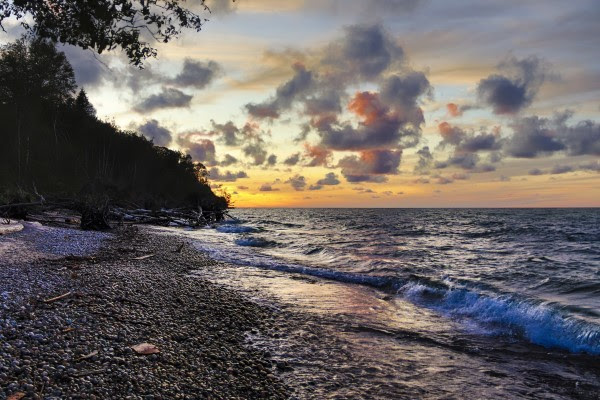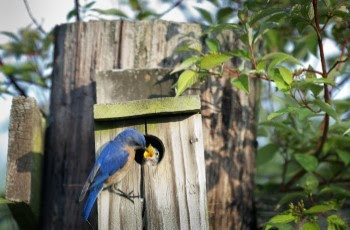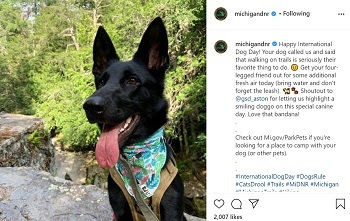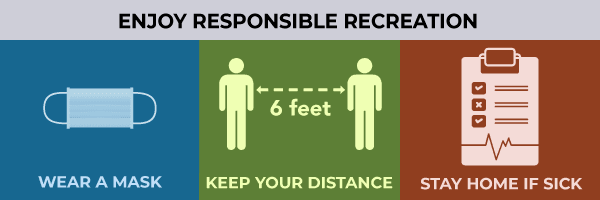| Some of this week’s stories may reflect the impact of COVID-19 and how the Michigan Department of Natural Resources has adapted to meet customers’ needs and protect public health and safety. We will continue to share news and information about the best ways to enjoy our state’s natural and cultural resources.
Follow our COVID-19 response page for FAQs and updates on access to facilities and programs. For public health guidelines and news, visit Michigan.gov/Coronavirus and CDC.gov/Coronavirus.
Here’s a look at some of this week’s stories from the Department of Natural Resources:
See other news releases, Showcasing the DNR stories, photos and other resources at Michigan.gov/DNRPressRoom.
Larger, higher-res versions of some of the images used in this digest are available below at the end of the email.
 Want to see more stunning pictures like this, taken by Michigan state parks photo ambassador Erick Rooker at Muskallonge Lake State Park in Luce County? Visit Instagram.com/MiStateParks to explore photos and learn more about the photo ambassadors! For more on the program, call Stephanie Yancer at 989-274-6182. Want to see more stunning pictures like this, taken by Michigan state parks photo ambassador Erick Rooker at Muskallonge Lake State Park in Luce County? Visit Instagram.com/MiStateParks to explore photos and learn more about the photo ambassadors! For more on the program, call Stephanie Yancer at 989-274-6182.
 Each spring brings a new generation of wildlife, and while you’re enjoying the sights of the season, be sure to give wildlife plenty of space to raise their young while you watch from a distance. Each spring brings a new generation of wildlife, and while you’re enjoying the sights of the season, be sure to give wildlife plenty of space to raise their young while you watch from a distance.
Young animals are often left alone, but the parents are never far. This is especially true for rabbits and fawns.
“One survival strategy wild mammal moms use is hiding their young while they are elsewhere, but don’t worry; they will return periodically to nurse and care for the babies,” said Hannah Schauer, wildlife communications coordinator with the DNR. “This tactic helps young animals stay safer from predators while mom goes elsewhere to avoid drawing attention to where they’re hidden.”
Eventually, the youngsters will be strong and fast enough to venture out on their own or accompany their mother.
“As we get later into spring and into the summer you might see fledgling birds hopping around on the ground, and this is completely normal,” said Schauer. “These fluffy youngsters are getting old enough to start trying to fly and need more space than the nest has. Their parents aren’t far and will continue to feed and care for them.”
Never remove an animal from the wild. Young animals are rarely abandoned and their best chance for survival is to remain in the wild.
Only licensed wildlife rehabilitators may possess abandoned or injured wildlife. Unless a person is licensed, it is illegal to possess a live wild animal in Michigan.
Learn more about what to do if you find a baby animal and get a list of licensed wildlife rehabilitators at Michigan.gov/Wildlife or contact the DNR Wildlife Division at 517-284-9453. |
 Thousands of miles of Michigan’s state forest roads are open for the public to use and explore. Under Public Act 288 of 2016, the DNR annually updates maps of state forest roads and notifies the public of any changes. New maps will be available online April 1 in an interactive web format and as printable PDF maps. Thousands of miles of Michigan’s state forest roads are open for the public to use and explore. Under Public Act 288 of 2016, the DNR annually updates maps of state forest roads and notifies the public of any changes. New maps will be available online April 1 in an interactive web format and as printable PDF maps.
Maps are updated each year based on changing road conditions, data cleanup and input received from public comment periods. Maps show which state forest roads are open to off-road vehicle use. It’s important to stay on these roads to prevent damage to the environment and wildlife habitat in these areas.
After the annual road inventory and review, the following will be open to ORVs:
- In the Upper Peninsula, more than 6,312 miles – roughly 98% of the total mileage.
- In the northern Lower Peninsula, about 6,101 miles – roughly 84% of the total mileage.
- In the southern Lower Peninsula, just over 9 miles of forest roads.
Review ORV rules, regulations, closures and more at Michigan.gov/ORVInfo. Find updated maps and other information at Michigan.gov/ForestRoads.
Questions? Contact Kristen Matson at MatsonK1@Michigan.gov or Tim Webb at WebbT@Michigan.gov. |
 Like most organizations getting started in social media more than a decade ago, the DNR took its first step on Facebook. Some staffers even remember the excitement at reaching 10,000 followers – a big milestone at the time. Like most organizations getting started in social media more than a decade ago, the DNR took its first step on Facebook. Some staffers even remember the excitement at reaching 10,000 followers – a big milestone at the time.
Today, the department’s online presence has grown to include Instagram (48,000 followers), Twitter (40,000 followers), YouTube (9,000 subscribers) and Pinterest (5,100 monthly viewers). And that DNR Facebook page? It’s now up over 238,000 followers!
The DNR has evolved socially from simple information posts to livestream tours of state fish hatcheries and Q&A sessions with wildlife and fish biologists and conservation officers, as well as plenty of short videos that help tell the story of outdoor recreation in Michigan.
“Our social media presence was even more critical in 2020 when people were increasingly eager to find outdoor spaces where they could spread out and just relax,” said Tyler Czarnopis, the DNR’s social media coordinator. “Because of our strong social connections, we were able to help people find nearby state parks, state forests, trails, hunting and fishing opportunities and many other resources that were helpful in navigating life during the pandemic.”
The DNR’s social accounts (67 in all, including dozens of individual state park Facebook pages and a state parks Instagram feed) are among the most active in state government. Czarnopis said the DNR receives over 75,000 messages a year through the department’s social channels.
“Looking ahead, we’re going to rely on our social channels throughout 2021, too, as the DNR celebrates its centennial year,” Czarnopis said. “Watch our platforms for centennial stories, programs and events, as well as creative ways to safely celebrate and learn about Michigan’s amazing natural and cultural resources.”
Connect with all of the DNR’s social platforms through the links above or at Michigan.gov/DNRSocial – where you’ll also find social links for the Michigan History Center and Mackinac State Historic Parks! |
 Helen Mandeville Martin (1889-1973) was a renowned geologist, educator and nature photographer. Her career as geologist and editor for the Michigan Geological Survey (part of the Michigan Department of Conservation, the forerunner of the modern Michigan DNR) began in 1917. Helen Mandeville Martin (1889-1973) was a renowned geologist, educator and nature photographer. Her career as geologist and editor for the Michigan Geological Survey (part of the Michigan Department of Conservation, the forerunner of the modern Michigan DNR) began in 1917.
She created many Michigan maps, collected historical land surveying documents and played a critical role in conservation education. She was inducted in the Michigan Women’s Hall of Fame in 1988.
In case you missed it, reproductions of two of her geological maps are available as prints and puzzles at the Michiganology.org shop! |
|
|
/Note to editors: Accompanying photos are available below for download. Suggested captions and photo credit information follow.
Baby birds: Keep your distance when observing wildlife. Young animals are often left alone, but the parents are never far. Learn more about what to do if you find a baby animal.
Helen Mandeville Martin: Helen Mandeville Martin was a renowned geologist, educator and nature photographer. Reproductions of two of her geological maps are available as prints and puzzles at the Michiganology.org shop.
Lower Michigan geological map: Helen Mandeville Martin created many Michigan maps, collected historical land surveying documents and played a critical role in conservation education. Reproductions of two of her geological maps are available as prints and puzzles at the Michiganology.org shop.
Social snapshot: Connect with all of the DNR’s social platforms through the links above or at Michigan.gov/DNRSocial – where you’ll also find social links for the Michigan History Center and Mackinac State Historic Parks!
ORV: The DNR annually updates maps of state forest roads and notifies the public of any changes. Find updated maps and other information at Michigan.gov/ForestRoads./
 Stay informed, stay safe: Mask up Michigan, DNR COVID-19 response Stay informed, stay safe: Mask up Michigan, DNR COVID-19 response
|